Fallout 76 Review
An online wasteland worth exploring
If you have ever played one of Bethesda’s ambitious but slightly broken open world RPGs, at some point, you may have wondered how the experience would translate to multiplayer. After successfully adapting the Elder Scrolls into an MMO-style online experience, Bethesda have opted to take a different approach with the Fallout franchise with Fallout 76, a multiplayer prequel to the series. Compared to the Elder Scrolls Online, F76 is much closer to the traditional single-player experiences put forth by the company, in particular Fallout 4, as the mechanics and systems from that game were seemingly used as a starting point for the new release. The results are mixed, with significant changes made to some aspects while others are left pretty much intact. Whether the game is for you will be entirely dependent on what elements of Bethesda’s open world games you enjoy, and what you are looking to get out of an online open world set in the Fallout universe.
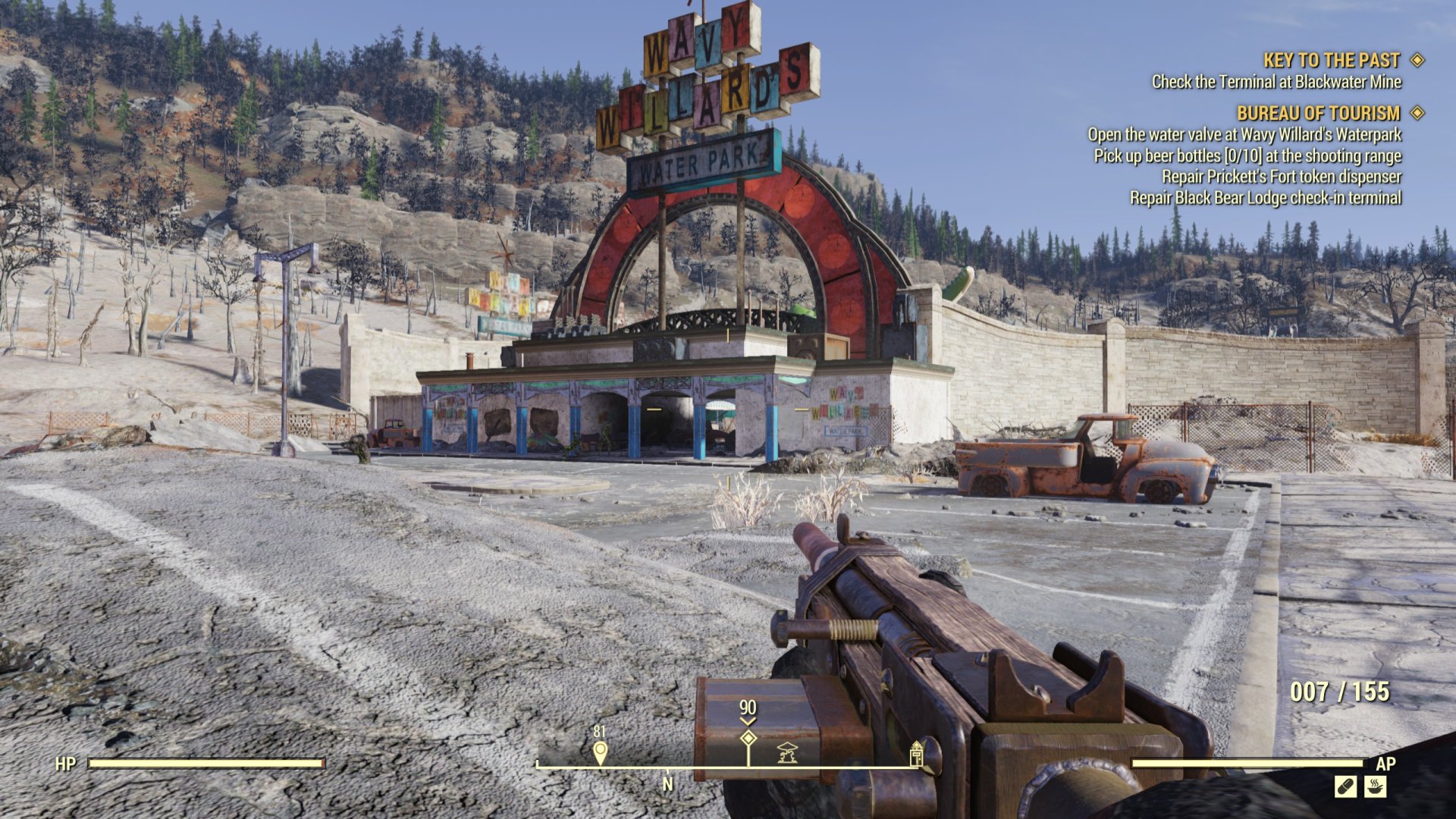
Fallout 76 takes place before all other games in the series, with you and other players taking the role of the first humans to emerge from a vault on Reclamation day, years after the bombs stopped falling. The fact that you are going out into an uninhabited wasteland provides narrative context for what might be the biggest change from previous Fallout games: a complete absence of human NPCs. Conversing with, travelling with and fighting human non-player characters comprised a substantial chunk of all previous main-line Fallout games, and this seemingly crucial component of the formula has been entirely removed. Though there are still a few friendly robots to interact with, the only humans you will encounter out in the world will be other players.
This might sound like a pretty big indictment right off the bat, since the Fallout series has traditionally been branded primarily as role-playing games, and choosing different dialogue options and making the odd story or quest-altering decision played a pretty big part of that. However, from my perspective at least, I always found interactions with NPCs to be some of the worst parts of these games, especially in Fallout 4 as outlined in my review of that game. A deeply flawed dialogue wheel, painfully dated animations, generally uninspired writing and flat voice acting, as well as some very buggy pathfinding with NPC companions made interacting with them my least favorite part. I even went as far as to say that Bethesda would be better off paring down these aspects if they didn’t significantly improve them.
Though I must say I was surprised to learn about the complete absence of human NPCs and all of the systems that go with them in F76, I can honestly say that for the most part, I didn’t really miss them. The world certainly feels a bit lonelier without them, but given that Fallout is set in a post-apocalyptic wasteland, loneliness fits the setting rather well. Having said all that, I can comfortably state that if conversing with NPCs and a focus on story and lore were major reasons for your enjoyment of the series historically, Fallout 76 is not for you.
With NPCs gone, the focus is shifted to what has always been my favorite aspect of the franchise: exploration and environmental storytelling. Fallout 76 is set in West Virginia, in what is easily the biggest, most visually appealing and diverse map the series has ever had; even if it lacks the incredible density of Fallout 4’s Boston map, it makes up for it with sheer diversity of locations, from forested mountains to more familiar hazy blown-out wastelands. There are countless locations to discover, with many of them telling their own little stories via a combination of detailed environments, notes found on computer terminals, or just lying around on paper, as well as audio logs. Every location, from the major towns to the small wilderness outposts, feels unique and is full of nooks and crannies packed with useful items. Different groups of AI enemies will fight each other, giving the world a dynamic feeling as you hear distant shootouts when exploring. The incredible level of environmental detail that made Boston and Washington so fun to explore previously is easily matched here. Though the world can feel lonely, it is anything but empty.
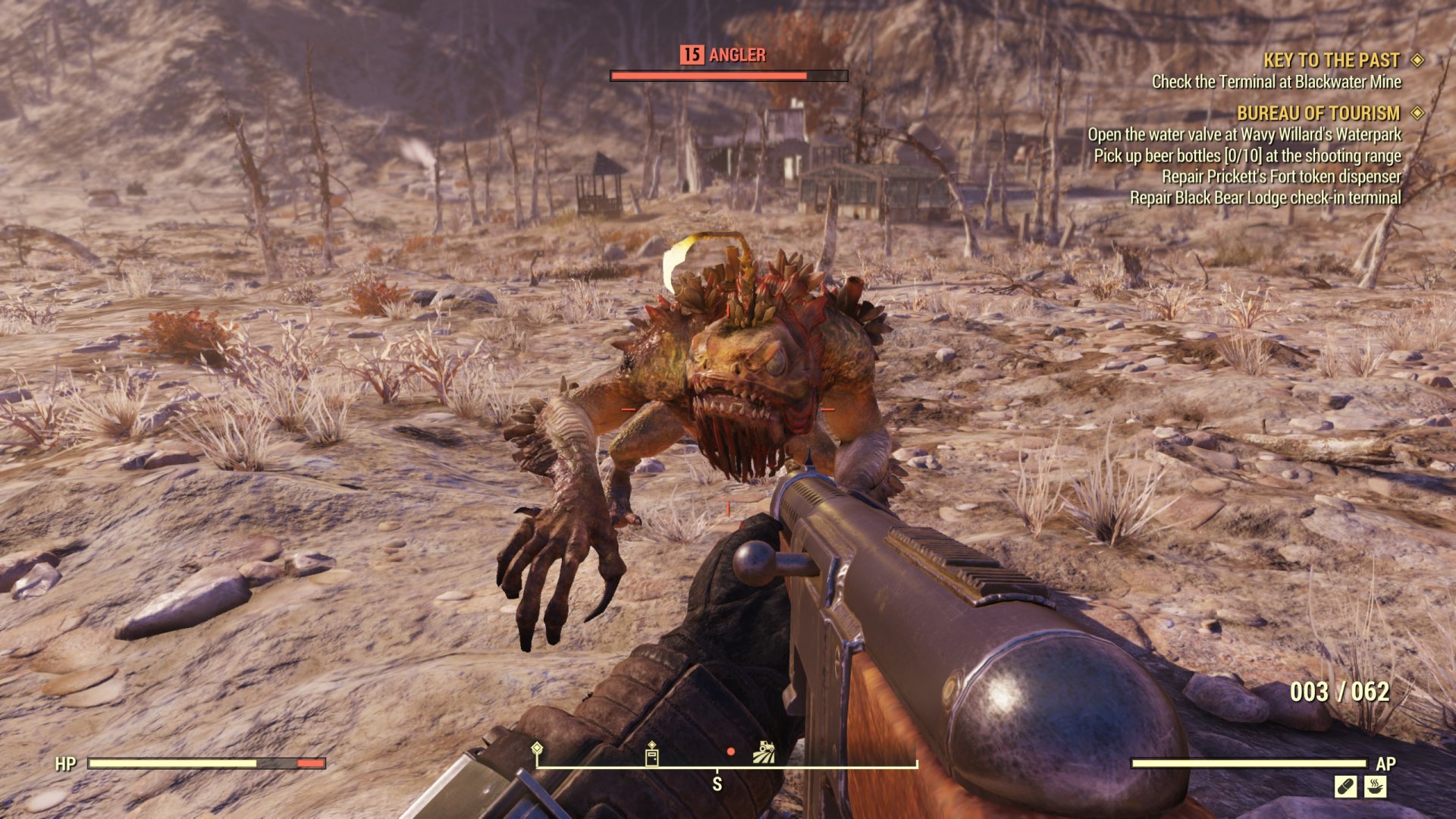
Once you emerge from the vault, there is a main quest to follow, which involves following in the footsteps of the Vault overseer, and learning about a disease that turned most people in the area (who survived the war but didn’t make it into a vault) into deranged, ashen creatures called Scorched. Though there are some interesting narrative elements, the main story quests, and quests in general, are pretty underwhelming in their design. Most of them just involve going to different locations to perform a simple task like interacting with a computer terminal, or listening to a series of audio-tapes that might give you insight into someone’s demise or struggle to survive, and inevitably a clue about where to find the next holo-tape.
Many quests lean into the sillier side of Fallout; you will work for a robot who historically served as the automated assistant to the Mayor of a town, but elected himself the new mayor one vote to zero after everyone else died in the war. Other stories are far more serious as you might listen to a series of audio logs from someone searching for a missing loved one, only for them to find that loved one had turned into a Scorched. The writing and voice acting is a bit of an improvement over Fallout 4, but some audio logs can drag on too long with overly-dramatic voice acting, and reading endless emails on terminals can become tedious. Really, the quests mainly exist as a motivator for exploring different parts of the map, an idea that is cemented by the fact that you discover most quests simply by exploring.
When you are out and about, you will inevitably run into something that begrudges your existence and wants to end your life immediately. When played like a shooter or first-person melee game, combat feels almost exactly the same as Fallout 4, meaning the weapons are quite satisfying to use, but the enemy AI can be very dumb and buggy. Most enemies just sort of walk towards you either shooting or trying to close the gap so they can smack you up close. The most advanced thing they might do is try to get away from a grenade. A great and highly varied arsenal alongside a mix of ranged/melee enemies means that combat largely remains enjoyable, especially in light of the much greater variety of sometimes horrific mutants and monsters to fight. Still, seeing enemies get stuck on the terrain or floating across the ground in a T-pose does happen more often than it should, and does break immersion.
If you preferred to use V.A.T.S. in previous Fallout games, you will be in for a bit of a shock as this system has been revamped to account for the shared online world. Time no longer slows down when you enter this hit-percentage based system, which greatly reduces its usefulness. I only ever found it worthwhile against smaller enemies like flying insects, or when I had a slow-firing weapon and was dealing with a mobile enemy up close. When aiming at enemies further away, if they are moving at all, the hit percentages change constantly and make the system much less reliable than simply aiming normally. Since your action points for V.A.T.S. double as stamina for sprinting and jumping, which you will probably be doing quite a bit of when trying to escape an un-winnable combat encounter, the new system can seem almost useless.
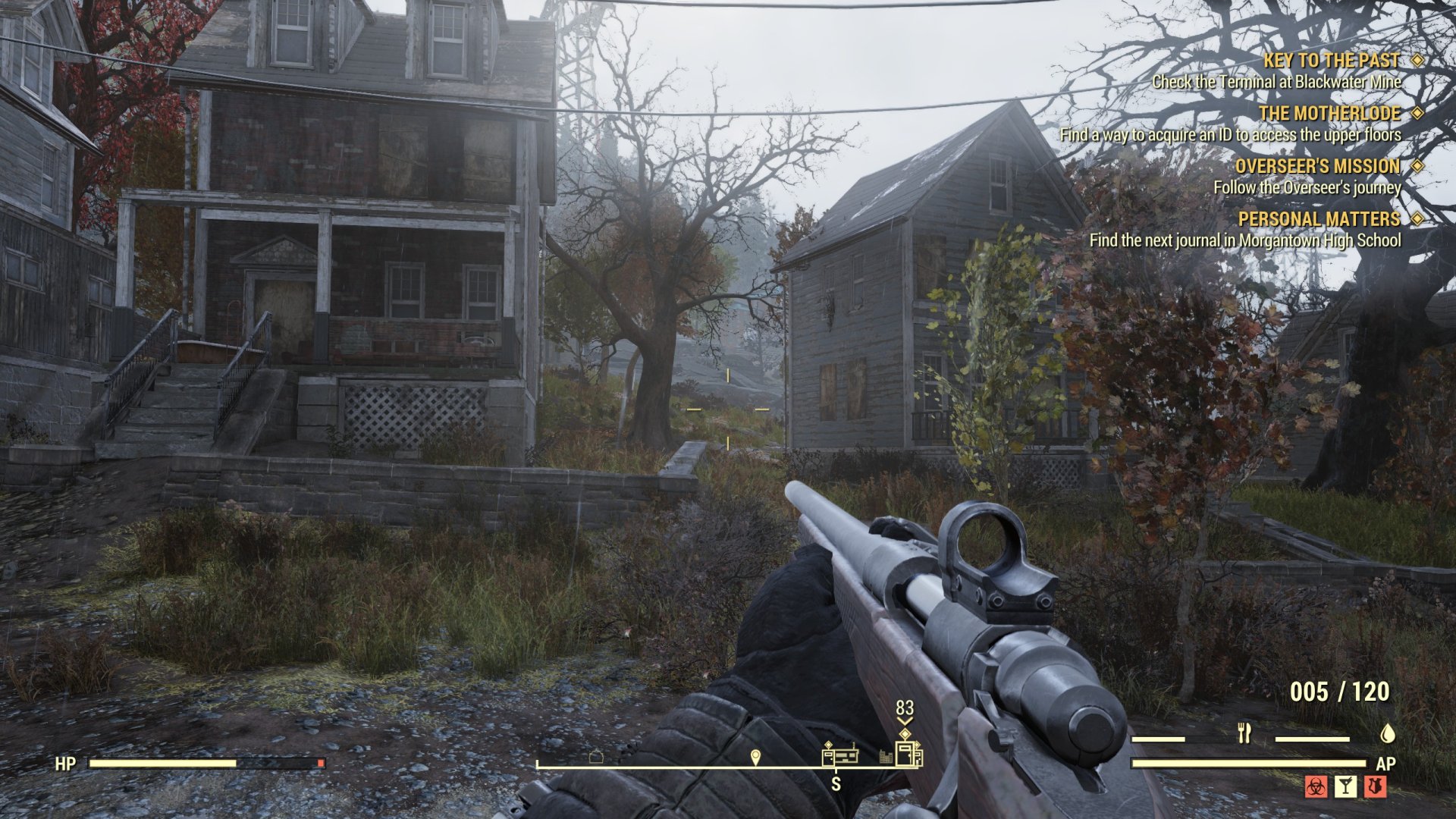
Fallout 4 introduced a fairly in-depth but rather finicky base-building system, and this returns to an even more prominent role in Fallout 76. Each player has a sort of combined hub/stash that can be deployed pretty much anywhere. Once deployed, you can use this for storage, but also as a starting-off point for building a base. The system of workbenches used for crafting and repairing weapons, armor and healing items also returns from Fallout 4, and while you will find crafting benches scattered around the world, it makes sense to have a centralised base where you can build and use all of these things while dropping off unwanted items and materials in your stash. Seemingly no matter where you put your base, it will get attacked by roaming mutants, ghouls or other creatures, and you can put up some basic defenses so you can fiddle around on crafting benches without interruption. There isn’t much motivation to build a large fortress beyond doing it for fun, but finding a good defensible position for your base can yield some satisfaction.
Each time you play Fallout 76, you are loaded into a random server with around twenty other players. When you leave the server, your base disappears from the map, and will reappear when you load back in. This is a clever solution that means you don’t have to worry about your base getting attacked while offline. If by some chance you join a server where another player has a base in the same location, your base will get sort of packed up into your central stash/hub, with blueprints created for structures. As a result, you can easily move your base at any time and quickly set yourself back up in a new location, a good system that generally works quite well in spite of the sometimes unwieldy building menus and issues with uneven terrain you will occasionally run into.
In order to use workbenches to craft and repair items, you will once again need to pick up the random clutter that fills the world and break it down into scrap at a workbench. As with Fallout 4, this provides good motivation for exploration, but some of the limitations that existed with the system in that game return. You can only carry a certain amount of weight, and since you are typically trying to find a specific type of material for crafting or repairs, it doesn’t make sense to pick up everything. Unfortunately, the only way to determine what crafting materials you get from scrapping a given item is to look at it in your inventory, so you will spend a lot of time early on picking up random objects, finding them in your cluttered inventory screen, then dropping them because they don’t have the parts you need. Inventory management in general is pretty finicky and you will end up spending a lot of time going through long lists of items looking for things to drop in order to free up space.
Once I got a feel for the different systems in Fallout 76, I fell into a really enjoyable rhythm of going out exploring or completing quests until I found myself with an inventory full of useful items, then returning to my base to craft, upgrade or repair weapons and armor as needed. Another significant change from previous Fallout games is that the requirement to eat and drink, which was previously only present when playing hardcore mode, is no longer optional. You will find food and drink out in the world, but it often makes sense to cook meals and boil or purify water at your base. Early on it can seem challenging to find enough food and water to keep yourself fed and hydrated, but upgrades to your character can help mitigate this.
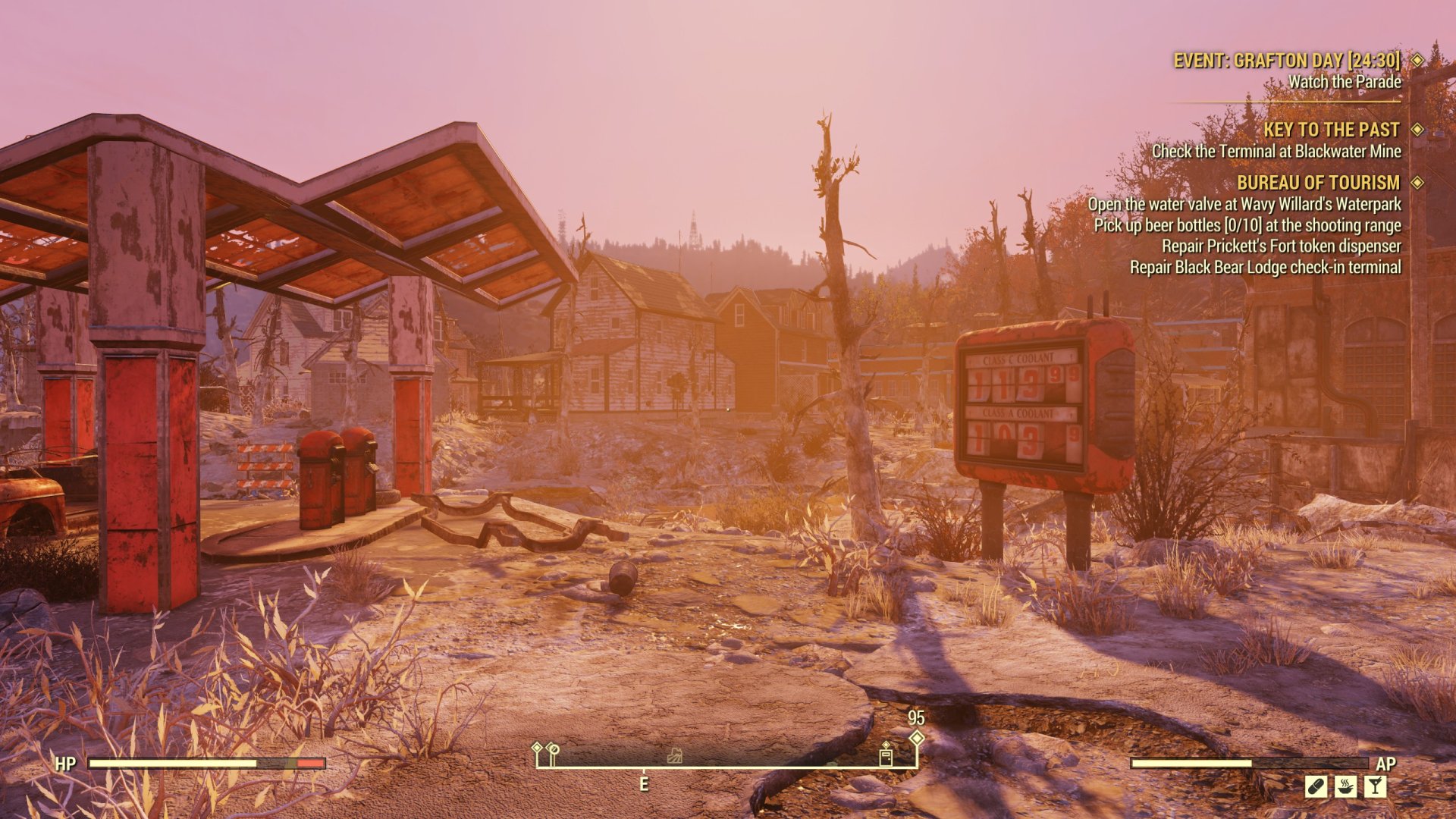
Leveling up and character progression has changed a bit since previous Fallout games. You still put points into primary stats such as strength, endurance and intelligence, but the perk system has been altered significantly. You now gain access to different perk cards, which are tied to different stats and offer bonuses. You can equip more or higher level cards for stats that you have put more points into. If you find multiple cards offering the same bonus, such as 15% increased healing from stimpacks, you can combine those cards to have a stronger effect, but you can equip fewer of these higher level cards. This is a generally good system that offers flexible character building, even though new cards are annoyingly unlocked via randomised card packs you get from completing passive in-game challenges.
The above constitutes would I would describe as the functional core loop of Fallout 76. You might have noticed that I have barely mentioned anything about the supposedly main feature of the game since the opening paragraph: Multiplayer. That is because the online aspect of the experience is in part superfluous, in part flawed, and generally undercooked. In a few ways, the multiplayer works well enough. Teaming up with a friend or two and exploring, getting into combat encounters and completing the event quests which are designed for multiple players is functional and even enjoyable, but Bethesda managed to bungle pretty much every other aspect of the online experience.
To start with, non-event quests are very poorly suited for co-op play, as these involve a ton of reading or listening to audio logs, which doesn’t exactly work well when you are chatting with friends over voice, especially when you need to access computer terminals, which only one player can do at a time. This limitation applies to most interactions, including using workbenches for crafting or trading with robots, meaning you will do a lot of waiting around while you take turns.
When playing alone, even though there will be over twenty other players in the server, they will be scattered over the entire map so you will rarely run into them. When you do, you can attempt to trade, but the trading interface is terrible and almost impossible to use unless you are communicating over voice, which isn’t always an option with random strangers; text chat is not in the game at all. You can engage in PvP, but until both players shoot each other, weapons do negligible damage, and the rewards for killing someone are minimal. Similar to how the Dark Zone works in The Division, if you instigate a fight with another player and kill them, you will become wanted and other players can kill you. Other opportunities for PvP arise when you take over ‘public workshops’ which involves defending a mine or factory against A.I. and human incursions alike, while repairing parts of it for a resource bonus, which can be attacked by other groups of players wanting that bonus for themselves. I didn’t see many people engaging with this aspect of the game, though this might change as the player base moves towards these types of end-game activities.
I did have a couple of cool emergent encounters with others such as one where I helped a lower-level player out in a fight as we were in the same town, or another time when a couple of higher level players appeared seemingly out of nowhere and helped me kill a tough enemy I was fleeing from. Coming across the base of another player out in the woods can be also interesting, but for the most part, the other random people that populate the map might as well not be there at all.
Perhaps the biggest failing of the online component is how multiplayer events are handled. A special icon on the map indicates a multiplayer event quest is present at a given location. These are designed to be completed with multiple players, but unless you go into them with a pre-made group of friends, there is no good way to find other people to do them with. You can’t matchmake into a group, or send out an invite to players sharing your world. However, when nearing these events by yourself, the quest will automatically be added to your quest log with a time-limit for completion and some kind of audio message, with a pop-up warning you about abandoning the quest if you stray too far. If you are completing other quests nearby, and are moving in and out of the event-quest boundary, these repeated audio-messages and popups can quickly become annoying.
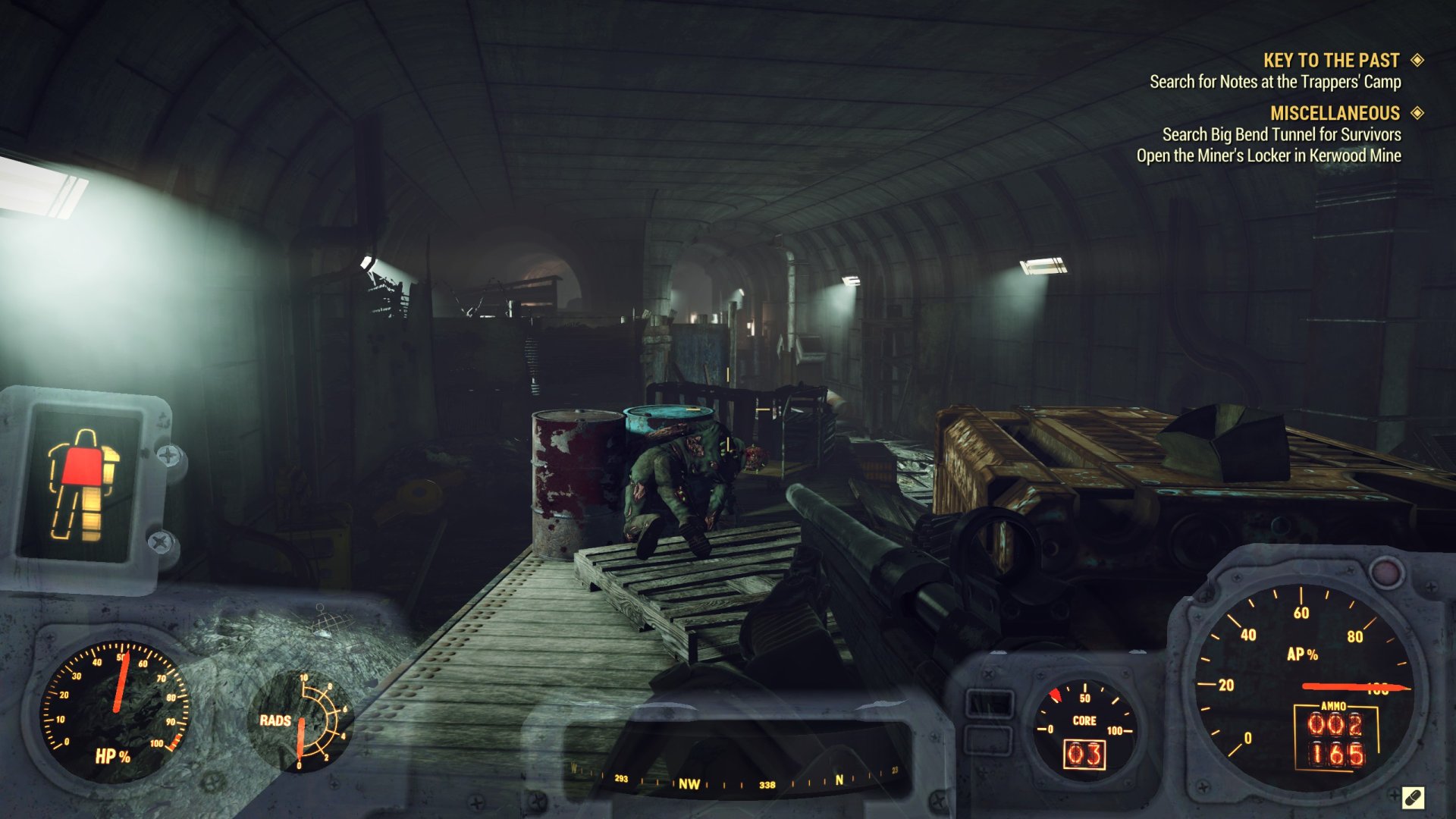
The main side-effect of the always-online world is that you can never pause the game. Given the amount of inventory-management required, this can be pretty annoying. You might be scrolling through the menu for a snack or pondering what missile launcher to drop so you can move again, when some random enemy starts attacking you, and quitting out of the clumsy menus often requires multiple button presses and takes longer than it should, and inconsistencies with what button is used to go back make it easy to press the wrong thing. The kinds of technical issues that Bethesda Game Studios are infamous for also permeate the online experience, as I experienced other players turning invisible, and had the prompt to trade with other players disappear on a couple of occasions. I got randomly disconnected from a server once and lost a few minutes of progress, but for regular maintenance an in-game popup notifies you when the servers are going down to let you safely quit.
Apart from this, as far as technical issues go, F76 ended up comparing favorably to Bethesda’s previous two games for me, but only by a bit. I didn’t encounter any broken quests and most bugs were limited to enemy AI breaking or behaving stupidly. I experienced a comical incident where my friend became stuck to a garbage can that he proceeded to walk around in, I got stuck in the terrain once, and had a couple of crashes and infinite loading screens in the thirty plus hours I spent with the game, but for the most part, things seemed to work as intended. Fallout 76 is far from polished, but by removing friendly NPCs, Bethesda inadvertently also removed a major source of bugs and glitches.
For better or worse, one thing that really makes Fallout 76 feel like a proper Bethesda open world game is the fact that it once again uses the same engine the company have been attached to for over a decade. Perhaps this is a feeling akin to Stockholm syndrome, but the engine didn’t bother me as much here as it did in Fallout 4. Though you will still need to endure substantial loading screens when entering the largest structures, it seems that more locations can be explored without them compared to previous games. Dynamic weather returns from Fallout 4, and can enhance the atmosphere with rain or nuclear blowouts that fill the air with green haze. Seeing some strange, massive structure off in the distance and being able to make your way to it, climb it and admire the view never got old largely due to the often striking visual design, in spite of the inconsistent texture quality, angular geometry and occasionally wonky depth of field effects. The game ran quite well for me with the settings cranked up at 1440p, though a couple of locations did cause the frame rate to dip a bit.
The audio is comparable to Fallout 4, to the point it seems like most of the same audio assets used in that game are recycled here. Even the radio stations seem to be playing mostly the same music. The sound design remains strong so this isn’t a huge issue, but between the comparable visual quality, borrowed audio and number of identical gameplay mechanics, F76 ends up playing like a sort of multiplayer expansion to Fallout 4 rather than a properly new entry into the franchise.
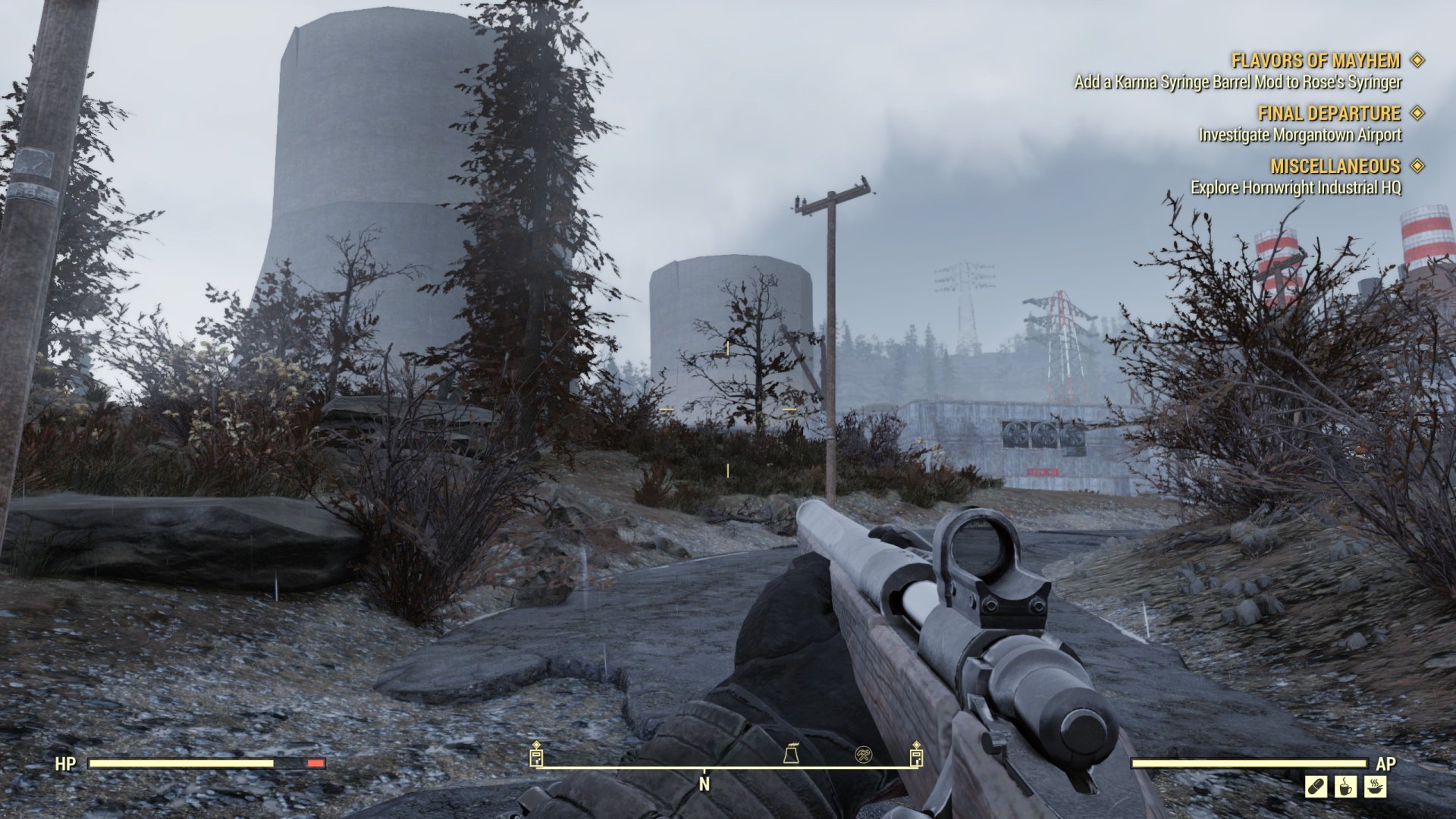
Fallout 76 represents a bit of an experiment for the series, and Bethesda’s inexperience with multiplayer games is glaringly obvious in this prequel. But despite some frustrating problems introduced to the gameplay by the always-online world and the removal of a conversation system and human NPCs, there is another worthwhile and frequently enjoyable post-apocalyptic adventure awaiting those who love the exploration and methodical character building of Bethesda’s unique brand of open world gaming. Though there is a healthy amount of content and plenty of fun to be had in the game right now, waiting for a few patches to hopefully iron out some of the technical wrinkles is likely a good option.
 Comments
Comments




















